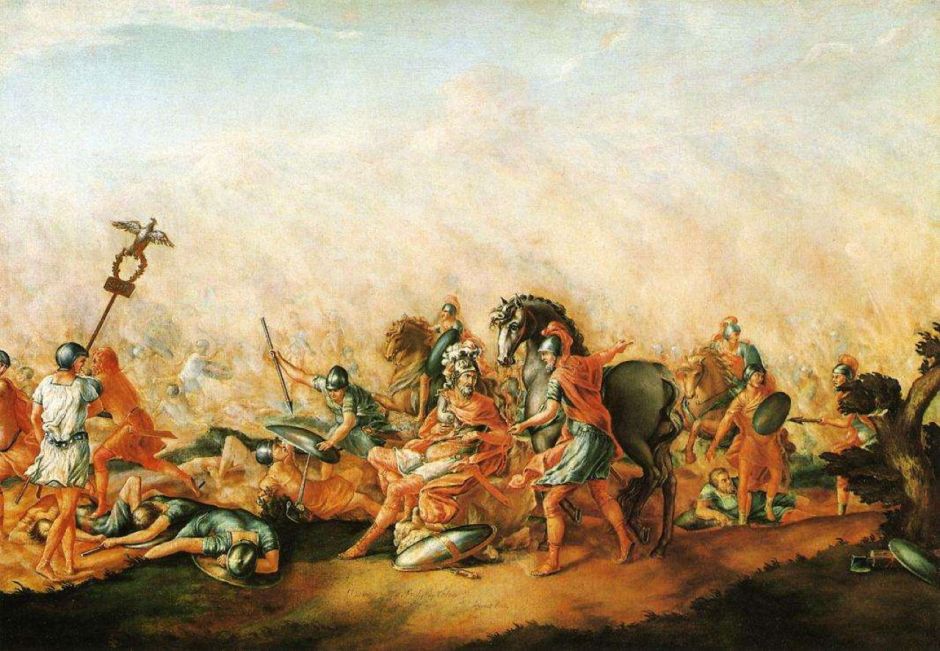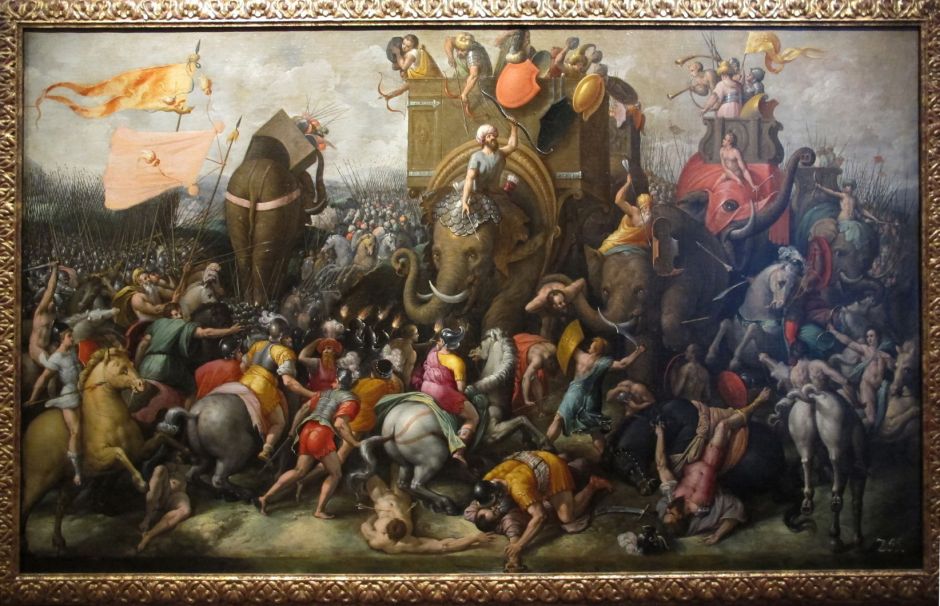The first of the Punic Wars saw Rome defeat Carthage after twenty-three years of costly and destructive fighting over the island of Sicily. The cost to Carthage was increased by the reparations it was made to pay to Rome, and its loss of control over the seas around Sicily. The Carthaginians used the following (relative) peace to take rich possessions in the south-east of Iberia (modern Spain), and in 221 BCE Hannibal became their ruling viceroy. Two years later he captured the Roman city of Saguntum there, drawing Carthage into a second war with Rome.
During the summer of 218 BCE, Hannibal famously led a huge army equipped with war-elephants north-east along the coast into Gaul (France) and crossed the Alps to arrive in northern Italy at the start of winter. The Romans, led by consul Gaius Flaminius, fought the Carthaginians by the river Trebia. In the midst of the battle, there was a major earthquake; the Romans were soundly defeated and put to flight, and Flaminius himself was killed. As a result, Fabius Maximus was made dictator.
Fabius appointed Marcus Minucius as his Master of Horse, and was given approval to ride a horse himself when in the field – an exceptional situation, as the Roman army was predominantly infantry, and traditionally commanded on foot. One of his first tasks was to raise morale among Romans, which he did by getting them to propitiate the gods.
His tactics against Hannibal were innovative: he kept his troops in hilly areas, which made it hard for enemy cavalry to come near. When Hannibal’s troops were on the move, he brought his men close enough for them to be detected, but kept them away from joining in battle. This waged a guerilla war of attrition, in which Hannibal’s army grew steadily weaker, while the Romans stayed in fine form.

Beccafumi’s Speusippus Tegaeatum and Fabius the Great shows two of the figures from his fresco cycle of The Political Virtues, from 1532-35, in Siena, Italy. Fabius is seen sitting in wait for Hannibal, rather than fighting him.
These tactics were not popular with his troops, who thought Minucius’ desire to go into battle was preferable. But eventually the tactics of Fabius won the day: after a misunderstanding with his guides, Hannibal’s forces were led down into a valley of the river Vulturnus. Fabius led four thousand of his heavy cavalry to block the outlet of that valley, then attacked the rear of Hannibal’s column.
Hannibal had torches tied to horns of some local cattle, and drove them towards the Romans at night. When those torches burned down, the cattle and surrounding forests caught fire, convincing the Romans that they were surrounded by advancing enemy. Hannibal was therefore able to escape with his army.
Fabius pursued the Carthaginians, but was beaten back by fearsome Spanish troops supporting them. Rome arranged an exchange of prisoners, then discovered that Hannibal had held back 240 Romans for ransom, which the Senate was not prepared to pay. Fabius arranged to sell sufficient of his own land to raise the ransom himself, and bought the release of all remaining prisoners of war.
Fabius was summoned back to Rome, leaving the Roman army under the command of Minucius. Although the latter had been told not to engage in battle, he waited until most of the enemy army were out foraging to attack those left in camp, and won a cheap victory. Back in Rome, after public speeches, the people voted for Minucius and Fabius to share military command.
When Fabius returned to the army, he found Minucius puffed up with conceit, and demanding sole command, which Fabius wouldn’t agree to. They therefore divided the army between them as Hannibal was preparing to occupy a hill between the two groups of Romans, and draw them into battle. Minucius fell into the trap, and his forces were surrounded and many killed by the Carthaginians.
Fabius then attacked Hannibal’s men from the rear, and his army fought its way through to rescue Minucius and his surviving troops. When the two Roman armies were united again, Minucius admitted his error and relinquished command to Fabius.
After this campaign, Fabius relinquished the office of dictator, and consuls continued to use his guerilla tactics to avoid direct engagement with Hannibal’s army, until Terentius Varro was appointed consul. The latter assembled a force of 88,000 Romans to take Hannibal on in battle, against the advice of Fabius.
The other consul alongside Terentius was Paulus Aemilius; when Fabius tried to persuade him to oppose Terentius, Paulus replied that it was better for him to face the enemy than another vote of the people. So the Roman army marched to Cannae, where at dawn they launched their attack on the Carthaginians.
Hannibal used two strategies: he fought with a very strong wind behind his men, which drove a huge cloud of dust over the Romans, causing confusion. He also arranged his men in a wedge, with the strongest at the outside, so that his best fighters could turn and attack the Romans’ flanks and then their rear.
Paulus’ horse was wounded, and unseated the consul. When others saw this, they dismounted to defend him on foot; this was misunderstood as a general order to dismount, and the Roman cavalry became infantry soldiers. Terentius fled to the city of Venusia to save his own life, but Paulus had multiple wounds and was killed.

The American history painter John Trumbull was still a student, and only seventeen, when he painted The Death of Aemilius Paulus at the Battle of Cannae (1773). This shows the consul surrounded by growing piles of bodies as Hannibal’s troops got the better of the Romans, and his refusal to flee the battlefield despite his own imminent death.
Hannibal’s army killed fifty thousand Romans, and took another fourteen thousand as prisoners of war. Rome had suffered its greatest defeat, and to the city’s surprise, Hannibal followed it up not by attacking Rome, but by winning over the rival city of Capua and much of the rest of Italy.
Back in Rome, the wisdom of Fabius was now appreciated, and he was again put in charge to restore order to its citizens. He stationed guards on the city’s gates to prevent the fearful from leaving, and placed a deadline of thirty days on all mourning for the dead. Fabius and Claudius Marcellus were then sent out with armies to deal with Hannibal. Fabius returned to his guerilla tactics, but Marcellus fell into an ambush and was killed by Hannibal.
Fabius won back the city of Tarentum by stealth. He got one of his soldiers into the city, posing as a deserter, who managed to win over the commander of Hannibal’s forces there. Fabius arranged a diversionary attack to draw Hannibal’s forces away, and surrounded Tarentum. Romans entered the city thanks to the insiders, and quickly overran its defences.

A fan of Fabius during the Dutch Golden Age, Jan Lievens’ painting of Quintus Fabius Maximus from 1656 may be referring to this victory at Tarentum, although it’s hard to read.
Hannibal was only five miles away at the time of the Roman repossession of Tarentum, and this made him realise the impossibility of mastering Italy. Fabius enjoyed a second triumph back in Rome.
Fabius’ son was made consul of Rome, and father and son went out with the army together. When they won another victory, the father let his son enter the city of Rome in a four-horse chariot, while he followed with the rest of the train. Sadly, Fabius’ son died early, and his father delivered the funeral oration himself.

Rembrandt’s painting of Quintus Fabius Maximus Visiting his Sons at the Camp of Suessa from about 1654 is another Dutch mystery, although one which we can no longer solve. Suessa was an ancient city in Latium which doesn’t appear associated with Fabius. This photograph is all that is left of a fine painting by Rembrandt which was stolen during World War 2, and is still missing, making it impossible to discover exactly what Rembrandt depicted.
As war ebbed and flowed in southern Italy and in Iberia, Rome opened a new front on the Carthaginians’ doorstep in north Africa. In 204 BCE, Publius Cornelius Scipio Africanus landed in Africa with legions he had assembled in Sicily. Scipio had a run of successes in battle, forcing the Carthaginians to recall Hannibal and his forces, and to enter negotiations with the Romans.

Between about 1570 and 1600, Cornelis Cort painted this magnificent work showing The Battle of Zama, which marked the last stage in the Second Punic War, in 202 BCE, in modern Tunisia. Contemporary accounts record that Hannibal here deployed no less than eighty of his war-elephants, shown here with their wooden castles mounted. Despite opening the battle with a charge of these formidable animals, the Romans under Scipio Africanus dodged them, and went on to defeat the Carthaginians on their home ground.

In 201 BCE, the Carthaginians reluctantly accepted harsh terms for peace with Rome, making what was once a great empire subordinate. JMW Turner harks back to the painting of Claude Lorrain to show this in the setting sun of his Decline of the Carthaginian Empire … from 1817.

